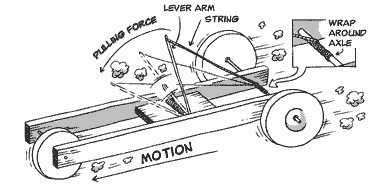Car that goes the longest distance
does not have to take the final!
Rules:
- Work on them individually, or in groups of two - if you work in groups, you split the reward if you win (ie - each person gets 50 extra points on final)
- Use one mousetrap to propel the car - (do not add electric motors etc. - your car can only be propelled by the mousetrap spring)
- Bring a video camera to record your run (phone)
- You will use the video to record x(t) to calculate velocities and accelerations from.
Grade:
1. Distance traveled (25 points)
4 points / ft
scores above 25 points get you extra credit
- 0-1 ft→ 4 points
- 1-2 ft → 8 points
- 2-3 ft → 12 points
- 3-4 ft → 16 points
- 4-5 ft → 20 points
- 5-6 ft → 24 points
- 6-7 ft → 28 points! (25 + 3 Extra credit)
score = 20 - 10*(Distance from center line / distance traveled)
https://www.youtube.com/watch?v=miHyjbepg8c
3. Design (30 points)
Weight: 10 points
- 0-200 g = 10 points
- 200-400 g = 8 points
- 400-600g = 6 points
Strength & functionality: 10 points
Robust Design that doesn't fall apart?
Smooth operation of parts?
Aesthetic appeal & creativity: 10 points
4. Top speed (25 points)
top 33% in class - 25 points
middle - 20 points
bottom 33% - 15 points
Tips:
Lightweight cars typically go faster & farther.
Do a google image search to see designs.
Make wheels out of:
- old CD's
- Records (you can get these at 1/2 priced books for ~ $1.00)
- Lids from plastic food containers
- old toy car wheels
We'll test them on the tile surface downstairs so you will need some kind of traction for your wheels:
- Wrap a rubber band, balloon, or other rubber material around your wheel.
Prior to race-day we will be:
- going through some dynamics concepts
- setting up excel spreadsheets for the data
- going through error propagation examples
Dynamics lab:
You will only need to write up the results section of this lab report, which includes:
- x(t), v(t) and a(t) graphs;
- your video
- your data
- example error propagation calculations.
and
Example car:
(Thanks Victor T.!)
Example data set (from above car)






